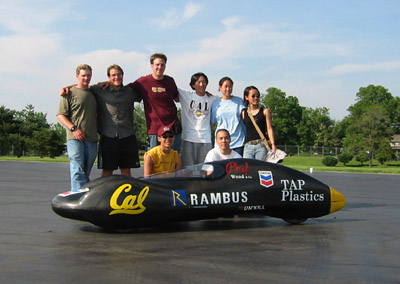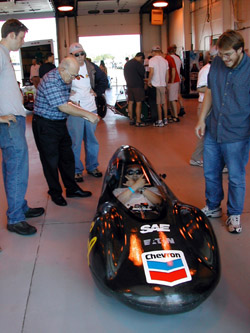|

|

|
NEWS
SEARCH
|
|
|
|

|
EXTRAS
|
|

|
 |
| The
lean and efficient Bear, with creators (standing,
left to right) James Jenkins, Kevin Ciocia, Matthew
Rogge, Benjamin Chui, Suzy Park, Jane Chen, and (kneeling)
Rui Lam and Kenneth Hsu |
UC
Berkeley students take top honors in fuel-economy competition
at 1,068 miles per gallon
27 June 2002
By Bonnie Azab Powell, Public Affairs
Imagine driving from Los Angeles to Seattle — on a single
gallon of gas. That's roughly equivalent to what a team of UC
Berkeley engineering undergraduates achieved on June 8, when
their vehicle won the Society of Automotive Engineers (SAE)
Student Design Supermileage Competition held in Marshall, Michigan.
Berkeley's 2002 entry, "The Bear" (apparently the team
saved its creativity for the design), beat out 20 other
colleges by squeezing an efficiency of 1,068.69 miles
per gallon from its standard-issue fuel bottle. Fortunately
for the driver, the Bear did not have to travel quite
that far: the performance segment of the contest required
only six laps around a 1.6-mile test track at a minimum
average speed of 15 miles per hour.
| |

Driver Ken Hsu climbs in the "carbon coffin" so
that supermileage competition judges can evaluate the vehicle's
technical and safety compliance
|
Energy-conscious Californians won't be rushing out to
test-drive this supermileage vehicle anytime soon. Yes,
it's 15 times more fuel efficient than the Honda Insight
hybrid car, but the Bear is definitely not for the claustrophobic.
"We call it the 'carbon coffin,'" says Ben Chui, the
Bear's main designer and a May 2002 graduate in mechanical
and materials science engineering. "With temperatures
around 90 degrees in the June heat, the inside of the
car can get up to 110."
Black, therefore, was probably not the most desirable
color for the vehicle's fairing (its aerodynamic external
shell). True, says Chui, but "the shiny weave effect of
the carbon fiber looked cool, and we didn't want any extra
weight." Without driver, the Bear tips the scales at 93
pounds. SAE rules specify that drivers can weigh no less
than 130 pounds, and the Berkeley team's two drivers,
Rui Lam and Kenneth Hsu, are as lean as jockeys in that
regard.
The competition rules emphasize driver safety, setting
strict guidelines for type of helmets, firewall placement
between the cockpit and engine, fire extinguisher location,
and how long it can take for the driver to exit the car
unassisted. The contest leaves the vehicle dimensions
up to the student teams: anything goes, as long as it
has at least three wheels, uses a standard-issue Briggs
& Stratton four-cycle engine, and runs solely on fuel,
with no human or battery assistance.
Founded in 1995, Cal's supermileage team didn't crack
the top 10 until the 2000 competition, when it came in
third among the college teams. Because several high schools
compete alongside the universities, that year Cal actually
placed fifth overall. Then in 2000, one high school, St.
Thomas Academy, set the contest's mileage record of 1,130.74
mpg. This year, Homestead High School of Fort Wayne, Indiana,
squeaked ahead of Berkeley into overall first place with
1,071.83 mpg. "They had a professional fairing on their
chassis," says Chui. "I guess it's a very good high school."
Compared to last year, the Berkeley team more than doubled
its efficiency. While the near-perfect conditions —
clear, calm weather and a recently resurfaced track —
no doubt contributed, Chui also points to a major design
change from previous vehicles. "We went with a fully enclosed
vehicle, with the wheels inboard," he says, "and that
gave us a significant aerodynamic advantage." Chui designed
the fairing without any aerodynamic analysis software,
using common-sense principles and design guidelines that
he learned in a mechanical engineering fluid dynamics
course. "The shape was really hard to fabricate, because
it's all fully compound curves," he says.
For
more information:
|
|
|
|
|
Development
of the Berkeley supermileage vehicle
|
|
Other
Berkeley student vehicle teams: CalSol,
the solar-powered car; Human-Powered
Vehicle; the newly formed Berkeley
Formula SAE
|
|
The
Society of Automotive Engineers' Supermileage
Competition home page |
| |
|
|
|
|
A custom, reverse-ratcheted rear wheel, made by sponsor
Phil Wood & Company, maximized performance of the
drive train, while racing-bike front tires with a secret
lubrication made coasting as frictionless as possible.
Most of the teams use the "burn and kill" racing method,
in which the drivers open the throttle and push the cars
up to around 30 mph, before killing the engine and coasting
to save fuel. An on-board bicycle computer keeps track
of average speed and distance covered so as not to be
penalized by falling below the average speed requirement.
Next year, the team plans to modify the stock engine,
which is permitted with certain restrictions, to eke out
a few more fuel-efficiency miles. Chui, who will be attending
graduate school at Berkeley, says the undergraduates will
be taking charge while he concentrates on raising the
$15,000 it takes to field a vehicle. "Most of that money
goes toward getting us and the vehicle to Michigan, which
is quite an expensive trip," says Chui. For the 2002 vehicle,
Chevron and the chip company Rambus each contributed $5,000,
while Tap Plastics chipped in a 40 percent discount on
materials.
With a top prize of only $500 at the Supermileage Vehicle
competition, these students clearly are motivated by something
more than NASCAR envy. "In mechanical engineering you
usually get just one hands-on course, ME 102B," Chui explains.
"This way, we get to apply what we learn in the classroom.
It's a big project, but it can be done in a year. Plus
it's just fun."
|

|